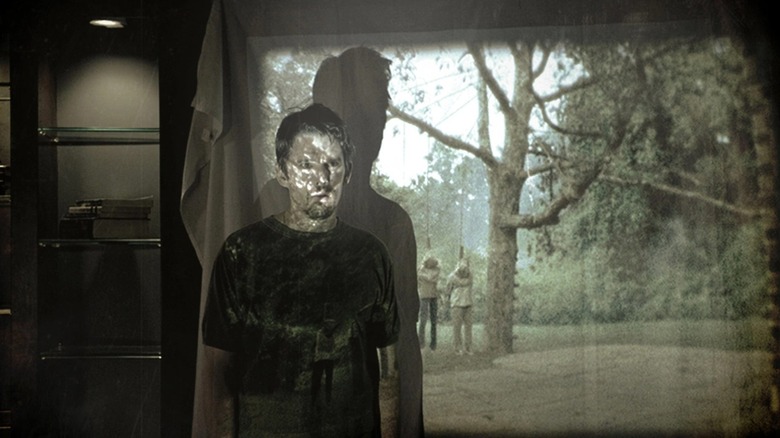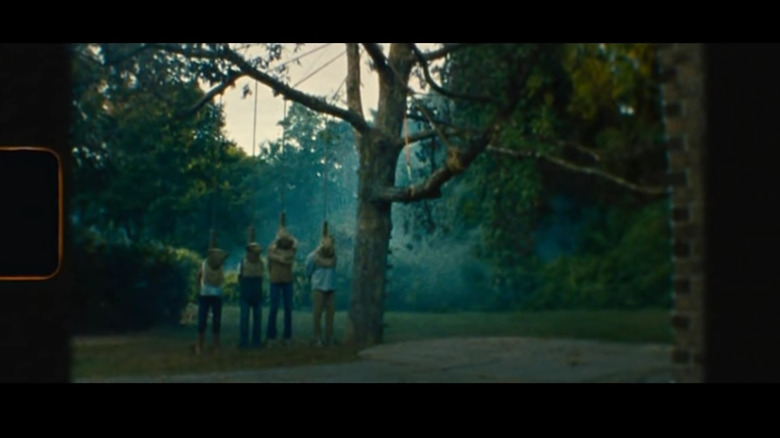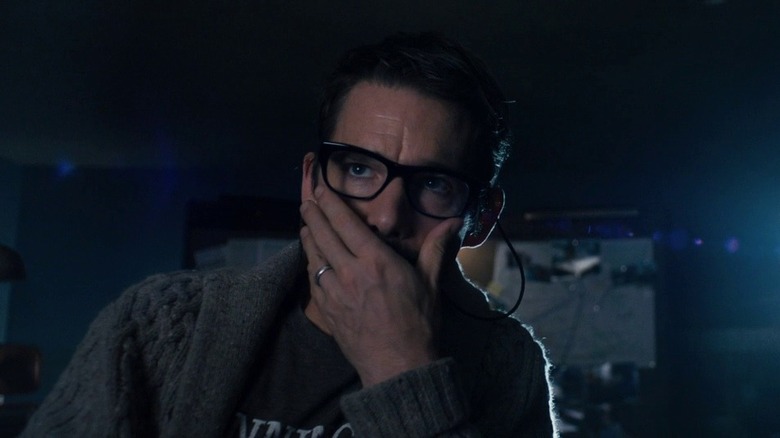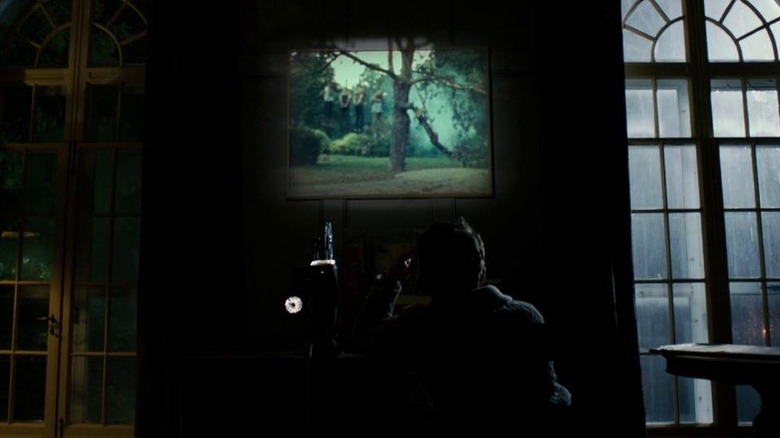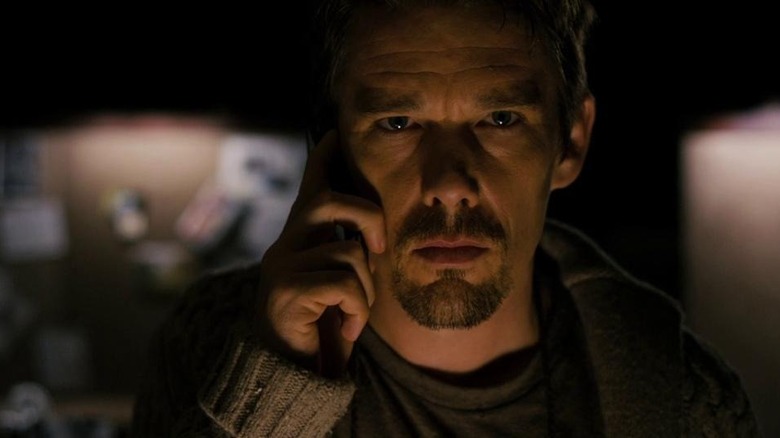The Wild True Story Of How Sinister's Terrifying Opening Scene Was Made [Exclusive]
"Sinister," 10 years removed from its original theatrical release, has cemented itself as one of our finest modern horror films. Directed by Scott Derrickson and co-written by C. Robert Cargill, it is a refreshingly original, twisted, and dark tale of a writer (played by Ethan Hawke) going too far in search of his next hit. Aside from being a genuinely great movie, it also made a ton of money and helped to establish the business model that made Blumhouse a powerhouse studio in the genre space.
I had the good fortune of speaking with Derrickson, Cargill, and several others recently for a comprehensive oral history on the making of "Sinister" for its 10th anniversary. One of the most surprising things in the entire movie is the opening sequence, which sees a family being hanged to death on Super 8 film, brutally and quietly. And in speaking with the filmmakers, I came to discover that committing that sequence to film was a complicated — and dangerous — undertaking.
Real tree, real problems
The opening scene shows off one of several "kill tapes" (as they would come to be called), Super 8 movies Ethan Hawke's Ellison finds in the attic of his family's new home. This one is particularly important as it sets the tone for the entire movie that follows. For a movie with just a $3 million budget, it was a big set piece that required a great deal of planning and precision.
"The tree in the back, obviously we had stunt people hanging in the tree to do that gag," production designer David Brisbin told me. "We designed very carefully to make sure that when the kids were getting hung, that there was foliage in front of them a little bit, so that it wasn't too intense and showing the children. But there was a problem on the first day that we were shooting, where the stunt really didn't go as safely and as well as it should have."
But before getting into what went wrong, it's important to realize how seriously the crew were taking this sequence. So much so that they actually moved a real tree to the set because that tree had the look they wanted. As art director John El Manahi explained:
"We used a real tree that we had cut down and brought in from Pennsylvania. We planted it into the ground with a giant welded steel stand that was like a giant Christmas tree stand. We had a time crunch because all the leaves on the tree were going to die. We had to reassemble the tree. The tree got cut down and then they numbered the branches and we reassembled all the branches on this tree. I had sculptors fill in all the gaps with this stuff called, I think it's called like paper bark or something like that. They use it in museum displays. I had scenic painters painting this tree."
An absent stunt coordinator leads to near-disaster
As Brisbin suggested, things didn't go well when the stunt was first executed, per the original plan. Derrickson revealed that the original stunt coordinator, who designed the complex shot, didn't actually show up to the final production meeting, which was the first sign of trouble:
"The stunt coordinator who designed the rigging for the hanging shot, and who also hired the stunt people for it, to my angry surprise, did not attend the final production meeting. Then, to my utter dismay, he didn't show up for the tech scout either — he was apparently too busy doing other things to show up and demonstrate exactly how the hanging shot would work."
El Manahi, who explained to me that he felt his part in the movie "was all the really f****** hard s***," had his doubts about the original plan from the beginning. He wasn't quiet about that to the rest of the crew during production:
"The stunt coordinator's idea was to have a crane on the front of the house that had the actors separately, and then we would time this branch falling down and then hoist these people up in at the same time. Now, I had told them, 'Under no circumstances should you get a crane.' I said, 'Do not get a crane. This is the worst idea. You cannot do it this way. This is going to be a disaster.' So I went out on a scout, I came back to the office and I overheard, 'The crane will be there on Wednesday or Thursday.' I said, 'Hold on a second. Crane?' They were like, 'We're going to have a crane.' I said, 'We cannot have a crane. That's going to be a problem.' I was ignored."
The stunt goes south
On the day of the attempted execution of the stunt, just about everything that could go wrong did go wrong. El Manahi, for his part, further detailed how he tried to get ahead of the issue:
"You have a rope that's attached to the branch and you have a rope that's attached to the actors, like a cable. When those two things go up, they separate. I was like, 'How are you going to camouflage this cable?' They were like, 'Nobody had an idea.' I said, 'I told you, you can't do it this way.' What I had to do was create a quick release so the rope would be attached to the cable, and as it went out, it would separate from the cable. But that means that you had to reset it every time. It was very, very difficult. I told them this was going to be a problem. It turned into a catastrophe. Everything shut down when the actor came out of his harness. So basically what they had were these harnesses and these stirrups. These guys are in these stirrups and they're being hoisted from the back, like it's around their back. The guy came out of his stirrups, so his harness went up around his neck."
As El Manahi predicted, the stunt did not go well and, in the end, one of the stunt performers who was hanging in the tree nearly got hurt when the harness went up around his neck. Production shut down and, on a movie with an already tight budget, cost thousands of dollars. "They couldn't get it in like... I'm talking about the whole day. We went there at 7:00 AM and now we are in two hours of overtime, 9:30 at night or something like that," El Manahi said. "They're trying to figure out how to salvage this thing. Then the guy comes out of his stirrup and it's like, 'That's it. Done. We're done.'"
"Thankfully, the incident didn't physically harm the stunt man, but it did shake him up badly," Derrickson said:
"I was furious because the attempted stunt was clearly not safe and had not been properly tested. I've only fired two crew members in my career, and in this instance, I fired the stunt coordinator on the spot, in front of the rest of the crew. We shut down production for three days, allowing us time to hire a new stunt coordinator and arrange to do the stunt safely."
Things get straightened out
Production shut down and El Manahi was tasked with figuring out how to execute the stunt safely. So, how was that accomplished? They went with El Manahi's original idea. "My original design was that we would have this branch that was a huge limb that would be on something like a big hinge. It's like a bank vault hinge," he explained. After the shutdown, El Manahi was called into an emergency meeting:
"So I get called into an emergency meeting and they go, 'We're going to do it your way. We're going dark for six hours. We need you to redo the tree.' I said, 'Okay.'"
For Derrickson, this was a watershed moment in his career as a director. For as much as that original stunt coordinator was to blame, the director ultimately took responsibility for what went wrong, and he's been as vigilant as possible going forward:
"I feel that this incident was ultimately as much my responsibility and fault as the stunt coordinator's. I never should have allowed his stunt to continue, having not seen it properly tested first. The director is the last and final watchdog for safety on any set. The buck stops here. This incident taught me that, and since then I have always made sure that I see with my own eyes that every possible precaution has been taken before filming any potentially dangerous stunt."
